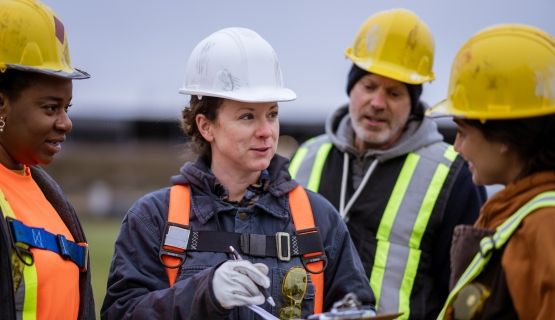Illness/injury prevention
IWH has a long history of conducting research to provide practical guidance to employers, workers, OHS professionals and regulators about what works and what doesn’t in injury or illness prevention. This research targets the injury and illness prevention practices of workplaces, as well as the programs developed by governments, health and safety associations and others to support and motivate workplaces to adopt effective practices.
Featured

At Work article
Differences in firm-level AI use for health and safety
To what extent are Canadian workplaces using artificial intelligence (AI) to help support workers’ health and safety? And what do these workplaces have in common? An IWH study surveyed firms across Ontario and British Columbia to find out.
Published: October 8, 2025

Impact case study
Saskatchewan’s construction safety group uses IWH tool to improve safety culture
This case study details how the Saskatchewan Construction Safety Association (SCSA) members have been analyzing IWH-OPM scores to adjust their safety practices and how SCSA has been using the data to tailor their outreach.
Published: February 10, 2025

At Work article
Newcomers often lack OHS protection and information in their precarious first jobs
They face difficulty finding work, due to language barriers, foreign credentials or lack of Canadian experience. Their first jobs are precarious, sometimes unpaid. To top it off, they receive next to no training on OHS and employment standards issues, as a new IWH study has found.
Published: February 2018
Project report
Project report
Implementing violence prevention legislation in hospitals: final report
This report details the findings of an Institute for Work & Health study that looked at acute-care hospitals in Ontario and how they implemented legislated violence prevention initiatives, to what effect, and the challenges they faced along the way.
Published: February 2018

IWH in the media
New immigrants vulnerable to workplace accidents
New arrivals in Canada face additional vulnerabilities on the job, according to studies by Institute for Work and Health (IWH) in Toronto, writes Ian Harvey.
Published: Daily Commercial News, January 2018

IWH in the media
Marijuana in the workplace: What is unsafe?
The federal government’s commitment to legalize recreational marijuana by July 1, 2018 raises occupational health and safety concerns for many employers. At the Institute for Work & Health (IWH), we have been reviewing the effects of various drugs that act on the central nervous system — including marijuana — on workplace injuries, deaths and near-misses, write IWH's Dr. Andrea Furlan and Dr. Nancy Carnide. What is striking is how little high-quality evidence there is on the impacts of marijuana in the workplace and how inconsistent the existing data is.
Published: The Conversation, January 2018
Project
Project
Costs of work-related injuries, illnesses and deaths in the European Union
Status: Completed 2019
Journal article
Journal article
Effectiveness of workplace interventions in return-to-work for musculoskeletal, pain-related and mental health conditions: an update of the evidence and messages for practitioners
Published: Journal of Occupational Rehabilitation, January 2018
Journal article
Journal article
Examining occupational health and safety vulnerability among Canadian workers with disabilities
Published: Disability and Rehabilitation, January 2018
Project
Project
Improving information on the incidence of work-related injuries and illnesses in Ontario
Status: Completed 2021

Impact case study
Concerns about newcomers’ safety at work lead organizations to IWH toolkit
Organizations working with recent immigrants are incorporating parts of the Institute's toolkit for teaching newcomers about workplace health and safety into their programming. Organizations in Ontario, Alberta, Northwest Territories and Nunavut, and even as far away as Australia, say the resource is just what they were looking for.
Published: December 2017

Impact case study
IWH model on breakthrough change used as foundation for WSPS small business strategy
An Ontario health and safety association, Workplace Safety and Prevention Services, turned to the Institute's model of breakthrough change to inform its approach to small business, especially the concept of finding the "knowledge transformation leader" within a small business to advocate for occupational health and safety change.
Published: December 2017